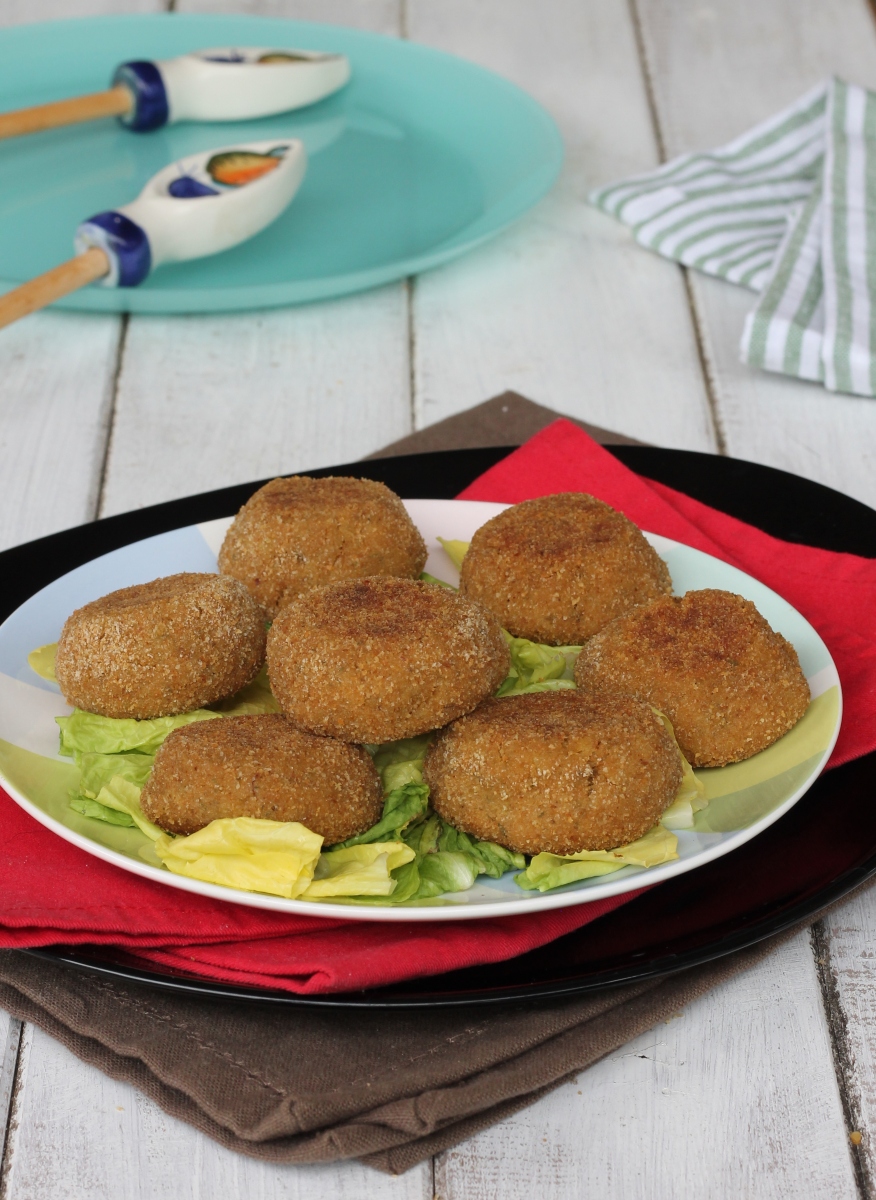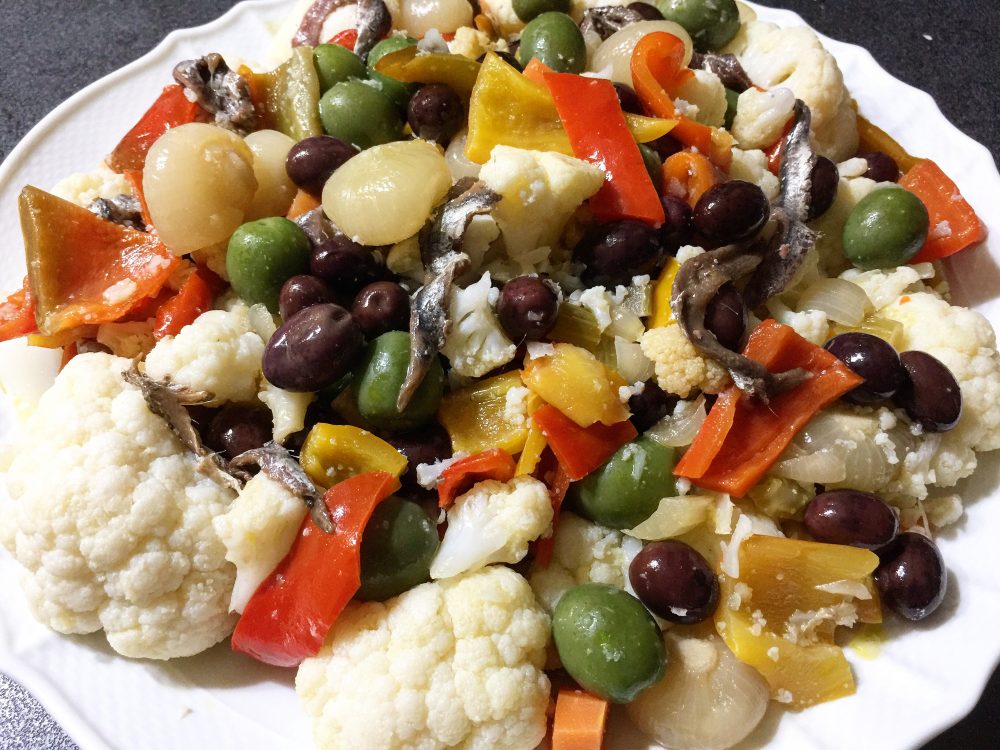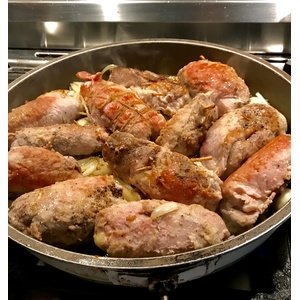Welcome to DU!
The truly grassroots left-of-center political community where regular people, not algorithms, drive the discussions and set the standards.
Join the community:
Create a free account
Support DU (and get rid of ads!):
Become a Star Member
Latest Breaking News
Editorials & Other Articles
General Discussion
The DU Lounge
All Forums
Issue Forums
Culture Forums
Alliance Forums
Region Forums
Support Forums
Help & Search
Cooking & Baking
Related: About this forumCooking On Pennies XVII Four From "Genaro's Cucina" 🌞

PARMIGIANA DI ZUCCA
Pumpkin parmigiana
Parmigiana was originally a dish made with aubergines and came from
southern Italy, namely Campania and Sicily, where aubergines grow in
abundance. This layered baked dish has, over time, become a popular dish
worldwide and has evolved to include other vegetables like courgettes,
artichokes, Swiss chard and pumpkin. Whereas aubergines are abundant
during the summer, pumpkin is plentiful during the colder season,
especially in rural locations where this autumnal squash provided
necessary nutrition for families and so was used in a variety of dishes. I
like to coat the pumpkin slices in egg and fry them (as I do with all other
vegetables when making Parmigiana). However, if you prefer a lighter
version, you could grill or roast the pumpkin slices instead.
Serves 4–6
1 x 1.4kg (3lb 1oz) pumpkin (you need approx. 1kg/2lb 4oz prepped
weight)
3–4 eggs
plain flour, for dusting
abundant vegetable oil, for deep-frying
2 balls of mozzarella cheese (each about 125g/4½oz), drained and roughly chopped
75g (2¾oz) grated Parmesan cheese
For the tomato sauce
2 tbsp extra virgin olive oil
1 small onion, finely chopped
3 x 400g (14oz) cans chopped tomatoes
6 basil leaves
sea salt and freshly ground black pepper
First make the tomato sauce. Heat the olive in a saucepan, add the onion
and fry over a medium heat for about 5 minutes, then add the tomatoes,
basil leaves and some salt to taste. Leave to simmer over a gentle heat for
about 25 minutes until thickened.
In the meantime, peel the pumpkin, cut it in half, then into quarters,
remove the seeds and then cut into slices about 5mm (¼in.) thick. Lightly
beat the eggs in a shallow dish with a little salt and pepper. Dust the
pumpkin slices with flour, shaking off the excess, then dip into the beaten
egg.
Heat plenty of vegetable oil in a deep frying pan until hot, then add the
pumpkin slices (you may need to do this in batches, depending on the size
of your pan) and deep-fry for a couple of minutes on each side. Remove
using a slotted spoon and drain on kitchen paper to absorb the excess oil.
Meanwhile, preheat the oven to 180°C fan/200°C/gas mark 6.
Line an ovenproof dish with a little of the tomato sauce, then place some
pumpkin slices over the top, sprinkle with a little black pepper, dot around
some mozzarella, sprinkle over some grated Parmesan and top with some
more tomato sauce. Continue making layers like these until you have
finished all the ingredients, ending with a final sprinkling of mozzarella
and grated Parmesan.
Cover with foil and bake in the oven for 15 minutes. Remove the foil and
continue to bake for a further 15 minutes until the cheese has melted and
has taken on a golden brown colour.
Remove from the oven and leave to rest for about 10 minutes before
serving.
*****************************************************************************

POLPETTE DI MELANZANE
Mini aubergine burgers
Aubergines, widely used and grown during the summer in southern Italy,
make a perfect alternative to meat. These are usually made into Polpettine
(small balls), but while testing, I decided to make them into mini burgers
for a change – same taste, different shape! If you prefer, you can make
them a little larger and serve them in a burger bun with salad leaves and
pickles for a delicious meat-free burger.
Makes 8 mini burgers
500g (1lb 2oz) aubergines
50g (1¾oz) crustless bread, soaked in 4½ tbsp of warm water
1 garlic clove, finely diced
10g (¼oz) dried breadcrumbs
20g (¾oz) grated Parmesan cheese
handful of flat-leaf parsley leaves, finely chopped
1 egg
abundant vegetable oil, for frying
sea salt and freshly ground black pepper
Place a large pan of water on to boil. In the meantime, cut the aubergines
into small chunks. When the water is boiling, tip the aubergines in and
blanch for a couple of minutes, then drain well and leave to dry out and
cool on a clean tea towel. Once cool, squeeze out all the excess water from
the chunks (this can easily be done by putting the aubergine chunks
through a potato ricer, if you have one).
Squeeze the soaked bread to remove the excess water, then roughly chop.
Combine the aubergines, bread, garlic, breadcrumbs, grated Parmesan,
parsley and egg in a bowl, then season with some salt and pepper to taste.
Form the mixture into eight mini burgers, each just under 1cm (½in.)
thick.
Heat plenty of vegetable oil in a deep frying pan until hot, then add the
burgers (you may need to do this in a couple of batches, depending on the
size of your pan) and shallow-fry over a medium-to-high heat for 2–3
minutes on each side until golden. Remove and drain on kitchen paper,
then serve immediately
***********************************************************************

INSALATA DI RINFORZO
Cauliflower salad
This colourful salad is a must on Christmas Eve tables in most Neapolitan
households, and it is traditionally eaten throughout the festive period,
adding vegetables and pickles to the bowl until the new year. This tradition
dates back to when nothing was ever wasted and whatever vegetables were
left over would be put in a jar with home-made vinegar to preserve. These
days, apart from the cooked cauliflower, the rest of the vegetables come
from ready-prepared pickles.
In Italy, Giardiniera is very popular and these ready-made jars of pickled
vegetables can be found in good Italian delis. And in Naples, sweet
peppers are a must in this salad. However, you can use whatever pickles
you prefer and include a variety like peppers, aubergines, carrots, celery,
gherkins and/or onions. If you make your own preserved vegetables, even
better, but shop-bought ones are just as good and very handy to keep in
your store cupboard.
This is my version of this salad, but you can add whatever you like and, as
they do in Italy, keep adding to it; you can also add more or less vinegar,
depending on taste. It is best made in advance and left to rest overnight in
the fridge so all the flavours infuse nicely.
Serves 2–4
½ small red onion, finely sliced
approx. 3 tbsp red wine vinegar
500g (1lb 2oz) cauliflower florets
approx. 200g (7oz) preserved/pickled vegetables (to include peppers),
drained10 pitted olives (black or green)
4 sun-dried tomatoes, roughly chopped
6 cornichons, drained and roughly chopped
4 anchovy fillets (optional)
¼ red chilli, finely chopped (optional)
2 tbsp extra virgin olive oil
sea salt
Place the red onion in a small bowl, cover with red wine vinegar and leave
to marinate.
Cook the cauliflower florets in a pan of salted boiling water for about 6
minutes or until just tender, but do not allow them to overcook and go
mushy. Drain well and leave to cool.
Place the cauliflower florets in a serving bowl together with the drained
red onion (reserve the vinegar), preserved/pickled vegetables, olives,
sundried tomatoes and cornichons, and the anchovy fillets and chilli (if using),
and toss together to mix. Drizzle over some or all of the red wine vinegar
from the onion, along with the olive oil, and toss lightly. If necessary, add a
little salt to taste.
Leave to rest at room temperature for at least a couple of hours before
serving, otherwise cover and leave overnight in the fridge, but serve at
room temperature.
***********************************************************************************

INVOLTINI ALLA GENOVESE
Rolled filled pork slow-cooked in onions
La Genovese is a typical Neapolitan dish of slow-cooked meat with lots of
onions. There are many theories as to why this Neapolitan dish is called
Genovese and one is that a dish of meat and onions was made by sailors
from Genova when docking in Naples. Another is that it was made by a
Neapolitan chef called O’Genovese. Whichever is correct or not, the dish
has nothing to do with the Ligurian town of Genova and is 100 per cent
Neapolitan.
The large amount of onions probably masked the flavour of cheaper cuts
of meat and was served with pasta to make the dish go further. Nowadays,
this dish is made with veal, pork or beef, and during cooking, the onions
exude a lot of liquid and melt down to gooey deliciousness. My version is
with pork involtini – pork loin slices that are filled and rolled, then cooked
in the onions. You can enjoy this dish as a main course with lots of good
rustic bread, or you could mix the onion sauce with freshly cooked pasta,
such as penne, and then the pork involtini.
Serves 4
8 slices of pork loin, approx. 750g (1lb 10oz) in total
½ handful of flat-leaf parsley, finely chopped
2 garlic cloves, finely chopped
15g (½oz) grated Parmesan cheese
3 tbsp extra virgin olive oil
1kg (2lb 4oz) onions, finely sliced
½ celery stick, finely chopped
1 small carrot, finely chopped
1 bay leaf1 rosemary sprig
100ml (3½fl oz) white wine
sea salt and freshly ground black pepper
rustic bread, to serve
Bash the slices of pork between two pieces of clingfilm to make them
thinner, then set aside on a chopping board.
Combine the parsley, garlic and grated Parmesan with a little salt and
pepper in a bowl, then place a spoonful on each of the pork slices.
Carefully roll up each slice with the filling inside, then secure each one
with a cocktail stick. These are your involtini.
Heat 1 tablespoon of olive oil in a large, deep frying pan over a medium
to-high heat, add the involtini and seal well all over, about 10 minutes until
golden brown. Transfer to a plate and set aside.
Heat the remaining olive oil in the same pan, add the onions, celery,
carrot, bay leaf, rosemary and a little salt and pepper and stir-fry over a
medium-high heat for 5 minutes. Add the white wine, return the involtini
to the pan, reduce the heat, cover with a lid and cook gently for 2½ hours.
If you find there is still a lot of liquid towards the end of the cooking time,
remove the lid and cook over a medium-high heat for a few minutes until
most of the liquid has evaporated.
Remove from the heat, discard the bay leaf and rosemary stalk and serve
the pork involtini with the onion sauce and lots of good rustic bread.
All the above from "Genaro's Cucina"
Tasty Italian for pennies.